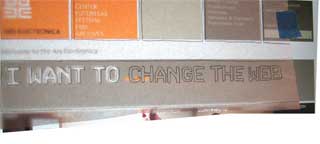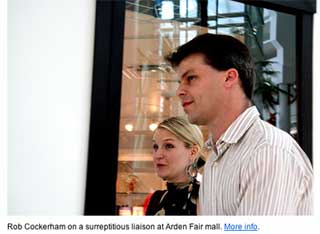 There were two great talks at the Pixelspaces panel. One of them was by Dan Phiffer (US) and Mushon Zer-Aviv (IL) who presented ShiftSpace, a project they developed at the ITP in New York (honorary mention in the PrixArs competition). I’ve got no image for it because my camera broke :-(
There were two great talks at the Pixelspaces panel. One of them was by Dan Phiffer (US) and Mushon Zer-Aviv (IL) who presented ShiftSpace, a project they developed at the ITP in New York (honorary mention in the PrixArs competition). I’ve got no image for it because my camera broke :-(
The first question they asked themselves was “Is there a public space on the web?� THen they demonstrated that the web is not really a public space.
First example they gave to illustrate their point was Christophe Bruno’s online work: The Google Adwords Happening. He tried to answer the question: “how do you make money from net.art?� that had popped up on the rhizome mailinglist. He decided that he’d start by losing money. So he bought some advertisement slots on google. They were not related to the key word he had bought the space for and were not mentioning any URL.
Many people saw his work. But after some time, he received a letter from Google saying something like “We think that you can do your work better, here’s a few tips: put the keyword on the title; add a clear description of your website and of course, please add the URL of your website. Bruno ignored the letter and left the ads as they were. He got another letter from google threatening him of taking down his adverts if he didn’t conform to the rules. The ads went off and Bruno’s attempt to create public art on the web with the pages of Google ended there.His example shows that google is a very private space.


Just like shopping malls…
Defenition of public space from wikipedia: “A public space or a public place is a place where anyone has a right to come without being excluded because of economic or social conditions, although this may not always be the case. One of the earliest examples of public spaces are commons. For example, no fees or paid tickets are required for entry, nor are the entrants discriminated based on background. Non-government-owned malls are examples of private space with the appearance of public space.�
 A personal anecdote from Dan: in California there’s a fairly famous website run by a guy called Rob Cockerham who makes pranks: cockeyed.com. He wrote a text on his website asking his readers to follow him in a shopping mall, stalk him as he shops and walks, take pictures of him and behave like papparazzi. But two picture takers were warned by a security guard that unless their cameras were put away they’d be escorted out. When they asked: But isn’t the mall a public space? They were told that, no, in fact a mall is a private property. Shopping malls are like the web, they have the appearance of a public space but they are private.
A personal anecdote from Dan: in California there’s a fairly famous website run by a guy called Rob Cockerham who makes pranks: cockeyed.com. He wrote a text on his website asking his readers to follow him in a shopping mall, stalk him as he shops and walks, take pictures of him and behave like papparazzi. But two picture takers were warned by a security guard that unless their cameras were put away they’d be escorted out. When they asked: But isn’t the mall a public space? They were told that, no, in fact a mall is a private property. Shopping malls are like the web, they have the appearance of a public space but they are private.
What is Shiftspace?
If you google “falun gong� on google.com you’ll get a different result than on google.cn because Falun Dafa is censored in China. ShiftSpace adds a note on the Chinese google results that says “Please note that these results have been censored. The un-censored top results should be falundafa.org.�
The artists then showed how they annotated the ars electronica website, hacking its motif. Another example showed a banner on myspace that said that it was Ruppert Murdoch’s space (he bought Myspace), so is it still “your� space?
How does ShiftSpace work?
You browse the net as usual and when a thingy note pops up, you’re informed that the website has ShiftSpace annotations on it. You can filter the notes. For example, decide to see only the notes written by your friends; you can notify ShiftSpace when a note is in fact Spam. The developers also got inspired by the digg system and ShiftSpace allows tho shift up or down a note, according to its interest.
Brief history of the Metaweb.
In 1999 Thirdvoice.com allowed web users to add annotations on a webpage. In 2001, Third Voice had to close. Many lawsuits against them.
In 2004, Greasemonkey let hackers inject code into a page to update it or add new features to the website.
If we compare Shiftspace, Greasemonkey and 3rd Voice, we get:
– Third Voice was a social system; it allowed just one application, was user-centric, it was a proprietary code;
– Grease Monkey wasn’t social, it allowed for various applications, there was no aggregation and it was Open code;
– ShiftSpace is social, it allows for various applications, is user-centric, has an aggregation interface and his code is open.
The tool is very approachable and it allows for people who are not familiar with the code to join the fun.
Now Shiftspace needs your help. How can you participate?
Use the platform and file in bug reports; help develop the core platform. The development heads are IF APIs; Data management; social network and reputation systems; privacy.
Join the mailing list on community.shiftspace.org.
On Tuesday, everyone is invited to the Installation Party at the electrolobby, Dan Phiffer and Mushon Zer-Aviv will install ShiftSpace on your machine. It takes 30 seconds.
Demo video.
Paparazzi image from Dan’s flickr page.
Related: Sascha has done a great interview of Christophe Bruno, Google Will Eat Itself.
